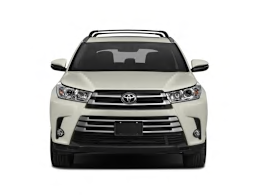You're drawn to the Toyota Highlander for its functional, family-friendly nature, frugal gas mileage, consistently good reliability, high resale value, and standard advanced safety features. Those buyers looking for snazzy styling, exhilarating performance, or an engaging driving experience should be forewarned -- these aren't the Highlander's strengths.
The Highlander is a practical three-row SUV with a manageable footprint and civilized road manners. It's one of the most popular vehicles among Consumer Reports subscribers and it does well in our owner satisfaction survey.
Most versions come with a punchy 295-hp, 3.5-liter V6 that is coupled with a new eight-speed automatic transmission. In our tests this combination returned 22 mpg overall. This powertrain gives the Highlander ample reserve power, but the transmission isn't the smoothest.
The Hybrid version uses the same V6 and adds a battery pack and three electric motors, increasing total system horsepower to 306. In place of the conventional transmission, the Hybrid uses a continuously variable type, which tends to make the engine moan when pressed. But the hybrid yields an impressive 25 mpg overall, best among all midsized SUVs. A four-cylinder engine is also available, but only on front-wheel-drive versions.
Out on the road, the Highlander corners soundly, but it lacks the sporty responsiveness of the Mazda CX-9. This is not a vehicle you want to have to hustle along a curvy two-lane road, although it is secure and predictable in emergency maneuvers. Ride comfort is commendable as the Highlander swallows bumps well and feels steady and composed. Noise levels are kept at bay.
Climb inside the cabin and there's some evidence of cost cutting, along with a bit too much hard plastic. The driver's seat is comfortable, but our $41,000 XLE has only a two-way lumbar adjustment. A three-person second-row bench seat lets the Highlander carry up to eight people. Comfortable captain's chairs -- standard in uplevel versions -- give the interior an airier feel and easier access to the third-row seat, but they limit seating capacity to seven.
Size-wise, the three-person, third-row seat is designed with kids in mind. It's easy to fold down, resulting in ample room behind the second-row seats. You can also fold the second-row seat, turning the Highlander into a cargo van of sorts.
Controls are mostly simple, with large, well-labeled buttons. Base LE versions use a small 6.1-inch screen for the infotainment system. All other Highlanders have a large, versatile 8-inch touch screen for the infotainment system, but it can be a far reach for taller drivers to access.
It is a simple process to connect your phone via Bluetooth, but the system only lets you access recent calls using the touch screen. Voice commands allow you bypass that; It's a very good system that lets you speak naturally rather than in awkward, robot-like phrases.
Toyota has included a variety of advanced safety gear -- including forward-collision warning and automatic emergency braking -- as standard equipment on every Highlander. This is important, as competitors often wrap these features as part of expensive option packages, or only offer them on more-expensive versions.
Overall, the Highlander is a rational choice that will appeal to the majority of buyers looking for a well-rounded, highly functional three-row SUV.


























